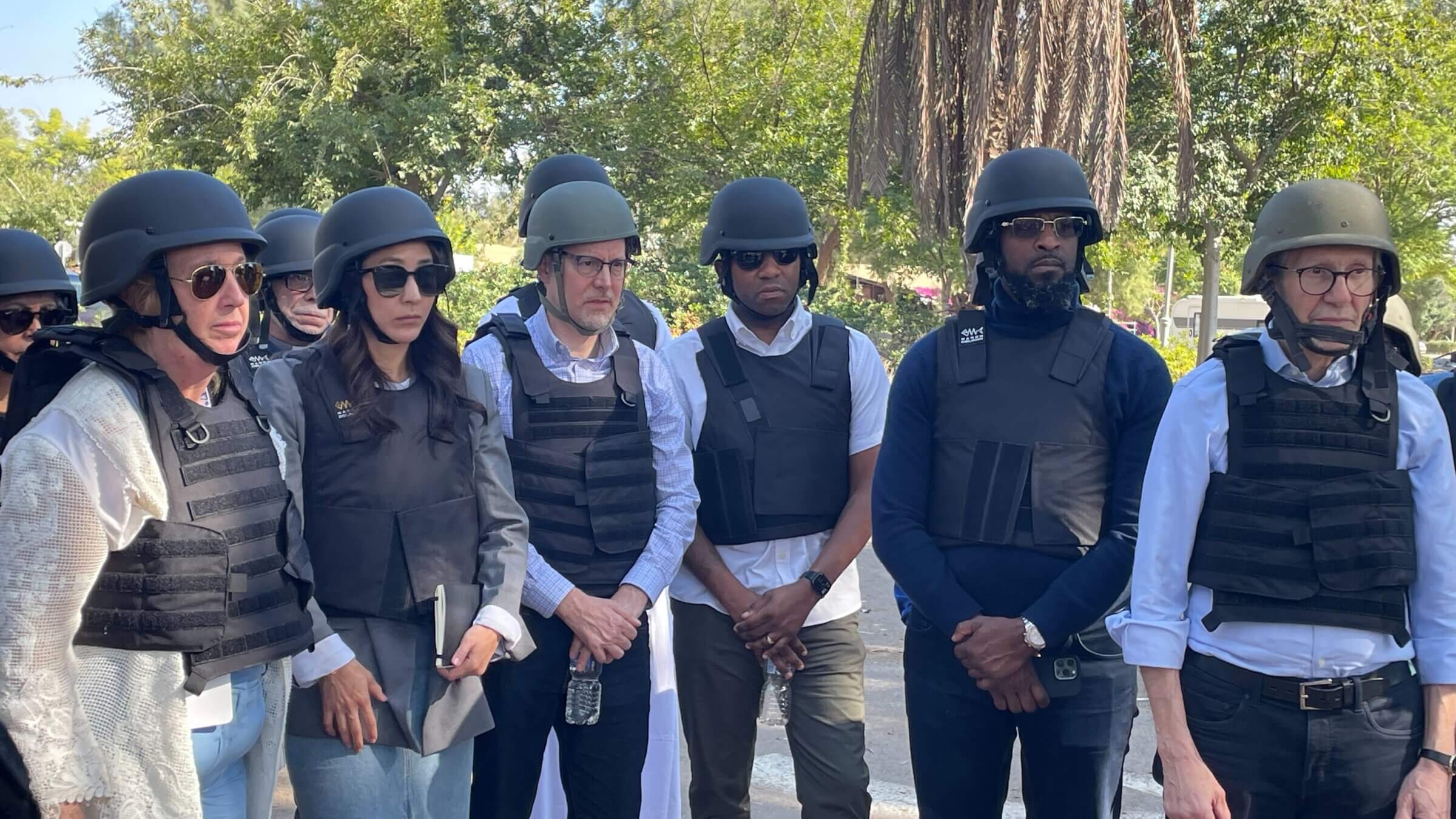‘House of horrors’: Shaken and tearful, a dozen New York politicians visit the devastation at a kibbutz near Gaza
The 12 Democrats said they are committed to sharing what they saw with their constituents

NYC officials visiting Kfar Aza, a Israeli Kibbutz devstated by Hamas, on Nov. 16. Photo by Jacob Kornbluh
KFAR AZA, Israel – Amanda Septimo, a Bronx assemblywoman who had visited this kibbutz months ago, didn’t have the heart to ask if any of the kids she played basketball with then had survived Oct. 7.
“It’s surreal in the worst way,” she said Thursday, tears running down her cheeks as she toured Kibbutz Kfar Aza, where Hamas killed more than 50 of its 400 residents last month. “Such an unspeakable tragedy.”
Septimo was one of a dozen New York politicians — all Democrats — who spent three days this week on a trip sponsored by the Jewish Community Relations Council of New York to see for themselves what the terror attack had done to Israel. At Kfar Aza, close to the Gaza border, they saw burned out child care centers and homes riddled with hundreds of bullet holes.
Mark Levine, Manhattan’s Jewish borough president, bowed his head and said he understood why survivors invoked the Holocaust as they described the day and its aftermath. “I can’t imagine the trauma,” he said.
And Donovan Richards, Queens’ borough president, once back in his Jerusalem hotel, said he still smelled the stench of death from Kfar Aza, the last stop on the trip. “What was done to innocent people is unfathomable,” he said.
The delegation also met with three women of Netiv HaAsara, an Israeli moshav located in Northern Negev near Gaza’s northern border. Fifteen of the farming community’s 400 members were killed by Hamas terrorists, some of them, the women said, just steps away from them.
Hamas killed 1,200 in Israel that day, and kidnapped 220 and took them to Gaza. As the New Yorkers walked through the Kibbutz Aza, they heard artillery and gunfire from Gaza, where the Israeli army is the midst of an offensive that has killed more than 11,000 people, according to the Gaza health ministry.
A 9/11
This week’s trip to Israel was the third for Septimo, whose family is from the Dominican Republic. The first was sponsored by the American Israel Education Foundation, a nonprofit educational arm of the American Israel Public Affairs Committee, which she went on in 2016 as a staffer to former Congressman José Serrano. At Kfar Aza, Chen Kotler Abrahams, a kibbutz resident who was celebrating Sukkot with her sister on the day of the massacre, served as tour guide.
“It’s so dark that it is almost hard to believe,” Septimo said of the destruction. “But you know it’s real because you are looking around and seeing it.”
She said the trip made clear the immediate threat of terrorism and the existential crisis Israel is facing “in a very human way.” At home, Septimo said, she would talk to her constituents about Israel’s security needs and the waste of lives in the Israeli-Palestinian conflict. “It’s an emergency that belongs to everyone.”
Levine, an outspoken supporter of Israel who earlier this year rallied with Israelis protesting the government’s judicial overhaul, compared Israel this week to the U.S. after 9/11. He said that the trip had changed him, though he couldn’t articulate exactly how. He said he would share what he had seen when he returned home, and remind constituents of the moral dilemma Israel faces as it hunts down terrorists in Gaza. Aid workers there describe a “humanitarian crisis.”
Levine said that he was also inspired by kibbutz residents, who relayed no desire for vengeance and had before Oct. 7 sought to strengthen ties to their Palestinian neighbors.
‘No way in hell that Hamas can exist’
Richards, who visited Israel as a member of the City Council in 2015, said he wished critics of Israel could personally witness the destruction wrought by Hamas and talk to witnesses to Oct. 7 he had met. “These were people who were sensitive to the plight of Palestinians,” he said. Perhaps if anti-Israel protesters “spoke to the individuals who had to watch their neighbors get murdered, babies kidnapped, they would have a different aspect,” he said.
“I don’t care who tweets at me,” he added. “It’s easy to tweet — you weren’t at the border. I was there on the front line; I saw it with my own two eyes.”
Richards said he’s opposed to calls for a cease-fire in Gaza as a supporter of a two-state solution. “After what I saw today, there’s just no way in hell that Hamas can exist,” he said. “Hamas needs to be taken out. And it needs to be replaced with a government who’s really going to have the interest of the Palestinian community, its growth and, most of all, want peace.”
The borough president said in New York he’s going to focus on initiatives to bolster tolerance and prevent hate crimes, including combating antisemitism in public schools and on college campuses.




















